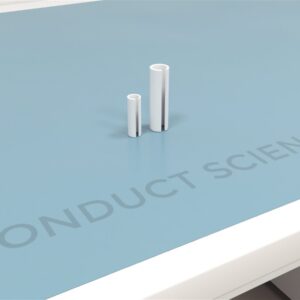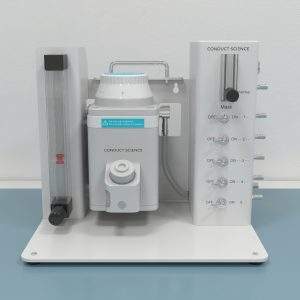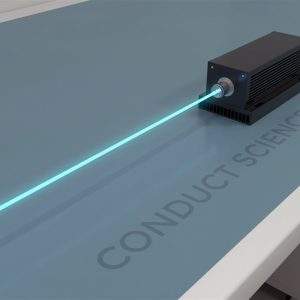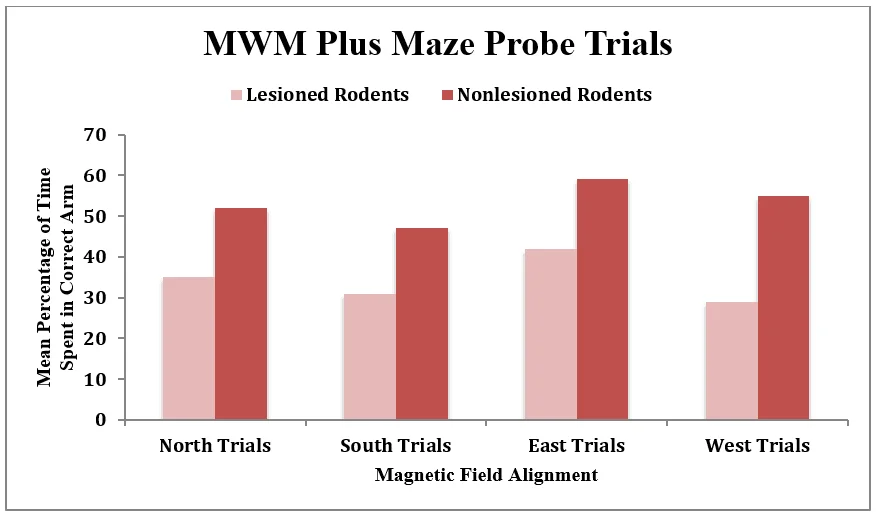The Elevated Plus maze insert for the Morris Water Maze is made to fit the 4 foot, 5 foot, or 6 foot sizing for the MazeEngineers Morris Water Maze. Made of stainless steel inserts.
The Elevated Plus maze insert for the Morris Water Maze is made to fit the 4 foot, 5 foot, or 6 foot sizing for the MazeEngineers Morris Water Maze. Made of stainless steel inserts.

MazeEngineers empowers preclinical neuroscience research with meticulously designed, customizable behavioral apparatuses. From manual classic mazes to fully automated smart systems, we provide the tools scientists need to capture high-quality, reproducible data for studies on learning, memory, anxiety, and depression.




Spatial exploration spans various vertebrate classes and encompasses an array of cues such as visual, olfactory, and auditory stimuli. Particularly noteworthy is the ability of animals to utilize the geomagnetic field and magnetic cues for spatial orientation—a phenomenon known as magnetoreception. While the traditional Morris water maze task (Morris, 1984) serves as a reliable measure of spatial ability, its limitations in studying magnetoreception prompted the development of the MWM plus maze (Phillips et al., 2013).
The MWM plus maze is a four-armed water maze that enables the manipulation of magnetic direction to observe magnetically-guided spatial behavior effectively. Built upon the straightforward design of the traditional water maze task, the apparatus requires rodents to locate a submerged escape platform in one of four possible arms. Success in the plus maze task hinges on establishing a magnetic north by modulating current flow in electric coils aligned along the four cardinal directions. Moreover, minimizing radio frequency interference through electromagnetic shielding and the absence of alternative directional cues eliminate potential confounding factors (Phillips et al., 2013).
The primary objective of the MWM plus maze is to ascertain whether rodents can employ magnetoreception to navigate the water maze task and to assess how swiftly and proficiently they can learn the relative position of the escape platform concerning the alignment of the magnetic field (Phillips et al., 2013). Compared to other stimuli like visual, olfactory, auditory, and vibrational cues, the geomagnetic field provides a universal reference frame that aids in organizing landmarks into a global map of familiar space (Phillips et al., 2013). Additionally, magnetoreception facilitates the intermodal integration of spatial information, offering a multifaceted approach to spatial cognition.
Water Maze Setup
The MWM plus maze stands as a modified rendition of the classic Morris water task, featuring a four-arm (plus) maze insert positioned within a deep tank filled with opaque water. These four arms align with the cardinal directions, providing a spatial framework for navigation. Submerged within the water, an escape platform is utilized during pretraining sessions, its placement relative to an assigned magnetic north serving as a crucial component of the experimental setup.
Management of Magnetic Fields
Enclosed within the apparatus are a pair of coils designed to manipulate the earth-strength magnetic field. Their primary role is to orient the magnetic north along one of the four horizontal alignments, corresponding to the arms of the maze. This setup enables convenient adjustment of the coils’ positions, facilitating alignment with geographic north, east, south, or west.
Elimination of Non-Magnetic Cues in the Training Environment
Creating an optimal environment for the MWM plus maze necessitates the removal of alternative directional stimuli. To minimize auditory cues, the training room must be sound-insulated, while visual asymmetries are avoided by employing a uniformly square room with consistent wall textures. Placing the maze apparatus at the room’s center, illuminated by a radially-symmetric overhead light fixture, ensures uniform visual conditions. Additional measures may include the use of an opaque water maze release device to prevent rodents from relying on distal cues, as well as the placement of a white curtain around the maze. To reduce directional vibrations, a vibration-dampened concrete base can be employed. Attention to factors such as room temperature and air supply further contributes to the creation of a controlled experimental environment.
Training Procedure
Rodents undergo a brief training regimen to acquaint themselves with the water maze and the orientation of the escape platform relative to the magnetic field alignment. The training comprises two trials. In the initial trial, the rodent is confined to a designated training arm of the maze by an acrylic partition, with the escape platform positioned in the outer section. Upon successfully reaching the platform, the rodent is allowed a 10-second exploration period before being removed.
Before the second trial, the magnetic field alignment is rotated by 180°, aligning the magnetic north with the original training arm and escape platform location. A 45-minute interval separates the two trials. In the subsequent trial, the rodent undergoes the same confinement within the realigned training arm, followed by the exploration period.
Testing Procedure
Each rodent undergoes a single testing or probe trial 18 hours post-training. For the probe test, the escape platform and acrylic partition are removed from the apparatus.
To disorient the rodent, it is initially placed in a snug cylindrical container (water maze release device), which is slowly rotated clockwise during transport to the testing room. The release device is then positioned atop an acrylic rod at the center of the maze, gradually filling with water until it submerges after approximately 50 seconds, releasing the rodent into the maze. The researcher exits the room to minimize visual cues.
The magnetic field alignment is varied across trials to ensure an equal distribution of rodents tested with each of the four cardinal directions (magnetic north in geographic north, south, east, or west).
Data Analysis
Rodent positions within the maze are recorded for 60 seconds post-release using a video tracking system such as Noldus Ethovision XT. The time spent by each rodent in each of the four arms is determined by analyzing the precise number of frames.


The data analysis involved plotting the mean percentage of time spent in the correct arm during the probe trial, relative to the position of magnetic north. The results depicted on the graph reveal a significant disparity between the lesioned and control groups. Specifically, the lesioned group exhibited notably impaired performance compared to the control group. These findings strongly indicate that rodents with lesions experienced altered or possibly eliminated directional responses to magnetic cues.
The development of the MWM plus maze stands as a crucial advancement in the exploration of magnetically-influenced spatial behavior in rodents, considering the widespread phenomenon of magnetoreception across vertebrate classes. Given the magnetic field’s significance as a global reference, it is improbable that magnetic cues do not impact directional or spatial behavior to some degree (Phillips et al., 2013). Consequently, the MWM plus maze offers a platform for comprehending the extent of this influence on spatial orientation. Moreover, the apparatus holds promise in uncovering previously overlooked roles played by magnetic cues in rodent spatial behavior and cognition.
The design of the apparatus enables precise manipulation of magnetic field alignments, ensuring accurate experimental conditions. Rigorous setup protocols guarantee the absence of alternative cues that might interfere with magnetoreception. Furthermore, the implementation of electromagnetic shielding effectively reduces radio frequency interference, addressing any unexplained variability observed in prior studies of magnetic compasses utilized in spatial behavior research. The straightforward and minimal training required for the MWM plus maze underscores the robustness of magnetoreception as a phenomenon.
Morris, R. (1984). Developments of a water-maze procedure for studying spatial learning in the rat. Journal of neuroscience methods, 11(1), 47-60.
Phillips, J. B., Youmans, P. W., Muheim, R., Sloan, K. A., Landler, L., Painter, M. S., & Anderson, C. R. (2013). Rapid learning of magnetic compass direction by C57BL/6 mice in a 4-armed ‘plus’ water maze. PloS one, 8(8), e73112.
There are no questions yet. Be the first to ask a question about this product.